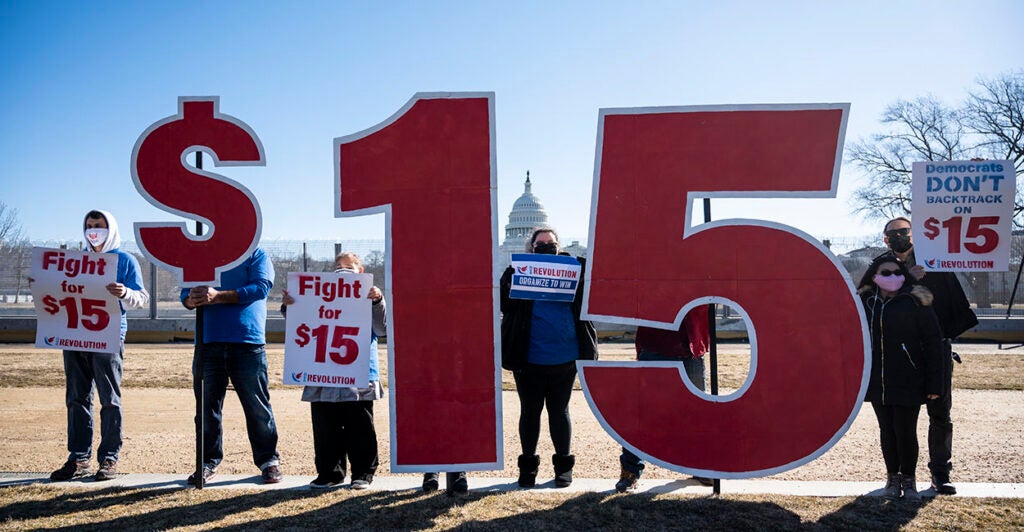Though the Senate parliamentarian rejected their efforts to include a $15-an-hour minimum wage in President Joe Biden’s so-called COVID-19 relief bill, Senate Democrats are scrambling for a way to include it.
Their efforts demonstrate the importance of this issue for the progressive left. But should they succeed, would such a measure truly help struggling Americans as promised?
And what exactly is that promise? Echoing his socialist ally Sen. Bernie Sanders, Biden recently argued that “[n]o one should work 40 hours a week and live in poverty.”
Sanders and Biden also speak of a “living wage.” But, if the goal is reduced poverty and increased wages, having government mandate a dramatic wage increase is not the way to get there. Job creation is the way to do it.
Let’s skip the politics and look at the data. The Census Bureau began reporting the poverty rate in 1959. Over those 60-plus years, the federal minimum wage has increased a number of times, but not in 2019. Yet, in 2019, the poverty rate plummeted 1.3 percentage points, the largest single-year decline in over 50 years, hitting a historic low of 10.5%.
Minority poverty saw the largest declines. Black poverty fell by 2 percentage points, Hispanic poverty fell by 1.8, and Asian poverty fell by 2.8. For the first time ever, black unemployment dropped below 20%. Child poverty dropped to 14.4%, the lowest rate since 1973.
Though it got little attention, “income inequality” also declined—and for the second year in a row—as the share of income held by the bottom 20% of earners increased by 2.4%. More than 4.1 million people emerged from poverty in 2019, the largest number since 1966.
Would a $15 minimum wage lift that many people out of poverty? Not even close.
The nonpartisan Congressional Budget Office recently issued a report on the Democrats’ Raise the Wage Act. It found that raising the minimum wage to $15 would lift only 900,000 people out of poverty, less than a quarter of those who escaped poverty in 2019.
So what caused 2019’s historic drop in poverty? Employers were competing for employees because the labor market was red hot. In every month in 2019, the unemployment rate was below what the Congressional Budget Office projected it would be, and there were 1 million or more job openings than people unemployed.
The total number of people employed hit historic highs. Competition for employees drove wages up 3% or more every month—with larger increases for low-wage workers than for high-wage workers.
As a result, the percentage of hourly workers earning at or below the minimum wage fell to 1.9%, the lowest percentage on record going back to 1979; the percentage working 40 hours a week or more fell to less than 1%. The average hourly wage for workers hit a pre-pandemic record high of nearly $24 an hour.
>>> What’s the best way for America to reopen and return to business? The National Coronavirus Recovery Commission, a project of The Heritage Foundation, assembled America’s top thinkers to figure that out. So far, it has made more than 260 recommendations. Learn more here.
To quote Frank Sinatra, “It was a very good year.” The Trump administration’s pro-growth economic policies—lower taxes, reduced regulation, and a focus on domestic energy production—created jobs and job openings. Wages rose, while poverty and income inequality declined.
Trump accomplished everything that Democrats claim their $15 minimum wage would accomplish—without a federal mandate.
Would a $15 minimum wage re-create the competition for employees that drove up wages and reduced poverty? No. It would kill jobs and reduce that competition.
When you increase the price of something, businesses try to use less of it. If you increase the cost of employing people, businesses will hire fewer people. That reduced hiring can manifest itself in various ways—reduced staff, reduced hours, reduced growth, and automation.
The Congressional Budget Office report forecasts that the proposed $15 minimum wage would kill 1.4 million jobs in the year that the wage took effect (2025). Between now and then, it would discourage hiring and wage growth as businesses planned for the future, knowing that their labor costs would be going up.
A phased-in approach works only if you assume that businesses invest based on their current, rather than their future, prospects. That would be a mistaken assumption.
Unfortunately, according to the Congressional Budget Office, young, less-educated workers would suffer most from the hike.
In January, economists David Neumark and Peter Shirley issued a study finding “a clear preponderance” in the literature that increasing the minimum wage negatively affects employment, particularly with respect to “teens and young adults as well as the less-educated.”
The lesson of 2019 is fairly simple. If you want to assure that people don’t live in poverty, pursue pro-growth policies that encourage job growth and the competition for employees that drives wage growth—without cutting young and less-educated people out of the labor force.
Wages increase and poverty decreases when workers, not jobs, are hard to find.
Originally published by RealClearPolitics
The Daily Signal publishes a variety of perspectives. Nothing written here is to be construed as representing the views of The Heritage Foundation.
Have an opinion about this article? To sound off, please email letters@DailySignal.com and we will consider publishing your remarks in our regular “We Hear You” feature.
